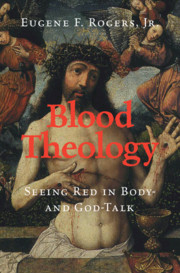Book contents
- Blood Theology
- Reviews
- Blood Theology
- Copyright page
- Dedication
- Contents
- Acknowledgments
- Part I Why We See Red
- Part II Blood Seeps in Where It Hardly Seems to Belong
- Part III Blood Makes a Language in Which to Conduct Disputes
- 5 Bridegrooms of Blood
- 6 Red in Tooth and Claw
- 7 Blood Purity and Human Sacrifice
- Part IV The Blood of God at the Heart of Things
- Appendix Review of Gil Anidjar’s Blood: A Critique of Christianity
- Sources Cited or Consulted
- Scripture Index
- Subject Index
6 - Red in Tooth and Claw
Creationism, Evolution, and the Blood of Christ
from Part III - Blood Makes a Language in Which to Conduct Disputes
Published online by Cambridge University Press: 22 March 2021
- Blood Theology
- Reviews
- Blood Theology
- Copyright page
- Dedication
- Contents
- Acknowledgments
- Part I Why We See Red
- Part II Blood Seeps in Where It Hardly Seems to Belong
- Part III Blood Makes a Language in Which to Conduct Disputes
- 5 Bridegrooms of Blood
- 6 Red in Tooth and Claw
- 7 Blood Purity and Human Sacrifice
- Part IV The Blood of God at the Heart of Things
- Appendix Review of Gil Anidjar’s Blood: A Critique of Christianity
- Sources Cited or Consulted
- Scripture Index
- Subject Index
Summary
In modern creationism, blood-language (even more than a high view of scripture) determines whether evolution can be true. In One Blood, leading creationist Ken Ham finds evolution too bloody for a good God. A good God could hardly use predation, extinction, and death as a means. For Ham, blood sets humans at one with or apart from the “dumb beasts.” But Ham drafts too narrow an atonement, where the blood of Christ makes up only for sin. Blood must also mean solidarity. Uses Irenaeus, William Jennings Bryan, Marilyn Adams, Teilhard de Chardin, Sergei Bulgakov.
Keywords
- Type
- Chapter
- Information
- Blood TheologySeeing Red in Body- and God-Talk, pp. 131 - 160Publisher: Cambridge University PressPrint publication year: 2021

